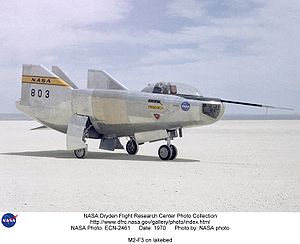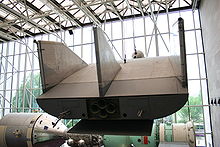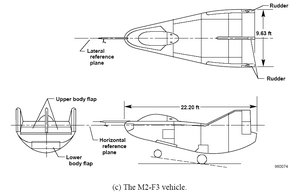Northrop M2-F3 Video - Great pictures and video
|
|
Northrop M2-F3
M2-F3

Role: Lifting body
Manufacturer: Northrop
First flight: 2 June 1970
Retired: 20 December 1972
Status: Smithsonian
Primaryuser: NASA
Developed from: NASA M2-F1
Northrop M2-F2
The Northrop M2-F3 was rebuilt from the M2-F2 at Northrop and redesignated the M2-F3 after the M2-F2 crashed at the Dryden Flight Research Center in 1967. It was modified with an additional third vertical fin - centered between the tip fins - to improve control characteristics. The "M" refers to "manned" and "F" refers to "flight" version.
Development
Early flight testing of the M2-F1 and M2-F2 lifting body reentry configurations had validated the concept of piloted lifting body reentry from space. When the M2-F2 crashed on May 10, 1967, valuable information had already been obtained and was contributing to new designs.
NASA pilots said the M2-F2 had lateral control problems, so when the M2-F2 was rebuilt at Northrop and redesignated the M2-F3, it was modified with an additional third vertical fin - centered between the tip fins - to improve control characteristics.
After a three-year-long redesign and rebuilding effort, the M2-F3 was ready to fly. The May 1967 crash of the M2-F2 had torn off the left fin and landing gear. It had also damaged the external skin and internal structure. Flight Research Center engineers worked with Ames Research Center and the Air Force in redesigning the vehicle with a center fin to provide greater stability. At first, it seemed that the vehicle had been irreparably damaged, but the original manufacturer, Northrop, did the repair work and returned the redesigned M2-F3 with a center fin for stability to the FRC.
While the M2-F3 was still demanding to fly, the center fin eliminated the high risk of pilot induced oscillation (PIO) that was characteristic of the M2-F2.
Operational history
First flight of the M2-F3, with NASA pilot Bill Dana at the controls, was June 2, 1970. The modified vehicle exhibited much better lateral stability and control characteristics than before, and only three glide flights were necessary before the first powered flight on November 25, 1970. The 100th flight of the heavy-weight lifting bodies was completed on October 5, 1972, with pilot Bill Dana soaring to an altitude of 66,300 feet (20,200 m) and a Mach number of 1.370 (about 904 miles per hour) in the M2-F3. Over its 27 missions, the M2-F3 reached a top speed of 1,064mph (Mach 1.6). Highest altitude reached by the vehicle was 71,500 feet (20,790 m) on December 20, 1972, the date of its last flight, with NASA pilot John Manke at the controls.

Picture - The M2-F3 at the National Air and Space Museum
A reaction control thruster (RCT) system, similar to that on orbiting spacecraft, was also installed to obtain research data about their effectiveness for vehicle control. As the M2-F3's portion of the lifting body program neared an end, it evaluated a rate command augmentation control system, and a side-arm control stick similar to side-arm controllers now used on many modern aircraft.
NASA donated the M2-F3 vehicle to the Smithsonian Institution in December 1973. It is currently hanging in the National Air and Space Museum along with the X-15 aircraft number 1, which was its hangar partner at Dryden from 1965 to 1969.
M2-F3 pilots
William H. Dana - 19 flights
John A. Manke - 4 flights
Cecil W. Powell - 3 flights
Jerauld R. Gentry - 1 flight
Most of text taken from NASA Dryden webpage.
Aircraft serial number
NASA M2-F3 - NASA 803, 27 flights
M2-F3 flights
Specifications (M2-F3)

Picture - NASA M2-F3 Lifting Body Diagram
General characteristics
Crew: one, pilot
Length: 22 ft 2 in (6.75 m)
Wingspan: 9 ft 8 in (2.94 m)
Height: 9 ft 6 in (2.89 m)
Wing area: 160 ft² (14.9 m²)
Empty weight: 5,071 lb (2,300 kg)
Loaded weight: 6,000 lb (2,721 kg)
Max takeoff weight: 7,937 lb (3,600 kg)
Powerplant: 1x— Reaction Motors XLR-11 four-chamber rocket engine, 8,000 lbf (36 kN)
Performance
Maximum speed: 925 knots (1,065 mph, 1,712 km/h)
Range: 39 nm (45 mi, 72 km)
Service ceiling: 71,500 ft (21,793 m)
Wing loading: 49 lb/ft² (242 kg/m²)
Thrust/weight: 1.3
Comparable aircraft:
X-24 -
M2-F1 -
M2-F2 -
HL-10
Living Warbirds: The best warbirds DVD series.
Source: WikiPedia